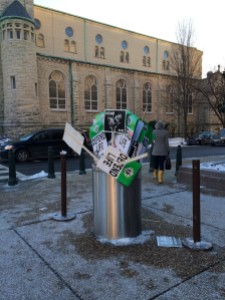On a frigid yet sunny day in January 2014, I happened to find myself a couple of blocks away from the annual March for Life in Washington, DC. I was in the capitol visiting the Folger Shakespeare Library for some research, and had arrived early in the morning for a long day of archival exploration (or, let’s face it, geeking out over old books). As the day went on and I occasionally stepped out for food or sunlight, I slowly realized what else was happening that day on the Hill. It was a special year for the March—the 40th anniversary—and thousands had managed to show up despite the 10-degree weather and recent city-stalling snowstorm. I myself am avidly pro-choice (and have been since I read The Cider House Rules in high school) so I will admit I was less than pleased to find myself among the throng of pro-life advocates. But I tried not to begrudge them their right to free speech, and instead went about my day just hoping that by the time I exited the archive for my evening commute, the hullabaloo would be over.
When I finally left the Folger, the march had finished and individuals were making their way out of DC. Yet what remained in their wake was the trash. Heaped in garbage bins up and down the streets were mounds of signs, flyers, stickers and other protest paraphernalia from that day’s rally. I first encountered the one below on the corner of 2nd and C street, SE, a block away from Independence Avenue. As I continued making my way to the Capitol South Metro stop, I came upon a large, discarded mass of signs apparently left by protestors afraid or unwilling to take them into the Metro station. There, gleaming under the setting winter sun, they lay discarded. As I made my decent down the escalator, I could see signs and flyers littered across the tiled floor, soaked in snow and mud from the previous day’s snowstorm; an overall-clad metro employee worked diligently to pick up the signs and place them in an already overflowing trash can.
I am positive that the amount of trash left by this protest is not unique. In fact, the conservative internet was abuzz with critiques of similar trash heaps left behind by climate protesters in New York City in September. Those critiques highlight the apparent hypocrisy of a protest which championed environmental stewardship, yet left masses of trash in its wake. Upon seeing the litter left by those attending the March for Life, I was taken aback by a similar sense of hypocrisy. A mere two weeks before the protest, Pope Francis had delivered his New Year’s Address to the Vatican Diplomatic Corps which included, among other things, a critique of “the throwaway culture.” This culture, wherein individuals frequently throw away “food and despensible objects” with impunity, upholds the value system that encourages women to discard unborn fetuses like food waste, the Pope claimed.
In this same address, the Pope also noted that “the greedy exploitation of environmental resources” is also a “threat to peace,” and that Catholics are called to pursue “policies respectful of this earth which is our common home.” In his New Year’s address Pope Francis called for an end to a culture of excessive trash and an increase in environmental activism. On that January day, I could not help but read the streets around me, littered with the snow-soaked signage of that day’s protest, as symbolic of the contradiction between the protestors’ message and its aftermath. If the individuals present were protesting the “throwaway culture” that can lead to abortions, they were doing so in a way that no doubt provided local landfills with an influx of trash.
The current protestors in Hong Kong have been praised, among other things, for their demonstration of environmental stewardship. As one protestor told the New York Times, “In this protest, we want to show our citizenship and our will to have a democratic government. Although this cleanup is a small thing, it is something that shows the values that all Hong Kong citizens should have.” For demonstrators in Hong Kong, their commitment to reducing conspicuous waste underscores their activist commitments; they see the connection between environmental rights and human rights.
Whatever the protest, it is worth considering the message conveyed by protest paraphernalia both during the active protests and after. The trash left by those marching against global warming in effect fueled the right’s criticism of the movement. Similarly, I could not take seriously a march that championed the sacredness of life, yet seemed to care so little for the planet on which future lives will live—or the lives of those who would spend over-time hours restoring the city to its pre-march condition. Yes, posters and signs are an effective means of communicating a message at a particular moment in time. But it behooves us to consider where those signs end up when we are done.
Melissa Welshans is a PhD Candidate in English at Syracuse University and is currently working on her dissertation The Many Types of Marriage: Gender, Marriage and Biblical Typology in Early Modern England. Melissa’s research is concerned with issues of gender and sexuality in early modern England, especially as it pertains to the institution of marriage. In her free time Melissa practices her nail art skills and snuggles with her husband and their two cats.


